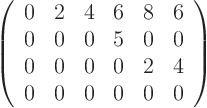| Analysis in Mechanical Engineering |
|
© Leon van Dommelen |
|
12.6 Null Spaces and Solution Spaces
To find the null space of a matrix, reduce it to echelon form as
described earlier. To refresh your memory, the first nonzero elements
in the rows of the echelon form are the pivots. Solve the homogeneous
system by back substitution as also described earlier. To refresh
your memory, you solve for the pivot variables. The variables
without pivots cannot be solved for and become parameters with
arbitrary values in the null space, multiplying “basis
vectors”. The coefficients inside the basis vectors come from
the solved variables or from writing trivialities.
For example, if your unknowns are  and your
echelon matrix is
and your
echelon matrix is
then the last equation is trivial and you get from the third
then from the second
then from the first
To get the null space (i.e. the full set of vectors
 that produce zero when premultiplied by
the original
that produce zero when premultiplied by
the original  ), the variables
), the variables  without pivots
go in the right hand side as arbitrary constants that can be anything:
without pivots
go in the right hand side as arbitrary constants that can be anything:
The coefficients for the pivot variables  in the
vectors in the right hand side come from the solved equations, and
those for
in the
vectors in the right hand side come from the solved equations, and
those for  from trivialities.
from trivialities.
To get a basis for the null space, you can use the constant vectors
in the right hand side:
(By definition any vector in the null space is a linear combination of
the above three vectors. And it is easy to see that the three are
linearly independent.)
If the above basis would contain fractions, you should consider
multiplying them by some nonzero constants to clean up. Note that
that will of course affect the given expression for the null space.
To find a solution space is almost the same as finding the null space,
except that you will use an augmented matrix to include the given
nonzero right hand side. The right hand side will produce an
additional vector in the solution space that is not multiplied by any
unknown. Therefore the solution space is not a vector space (assuming
that the given right hand side is not zero) and has no basis.
![]() and your
echelon matrix is
and your
echelon matrix is

![]() that produce zero when premultiplied by
the original
that produce zero when premultiplied by
the original ![]() ), the variables
), the variables ![]() without pivots
go in the right hand side as arbitrary constants that can be anything:
without pivots
go in the right hand side as arbitrary constants that can be anything:

